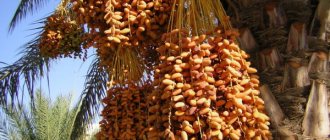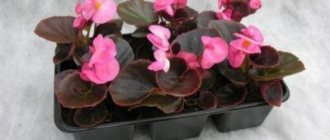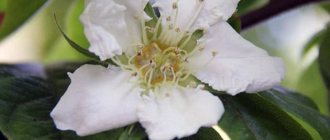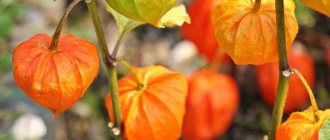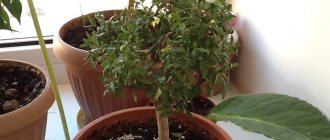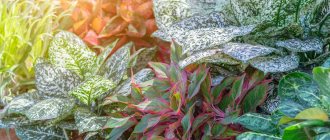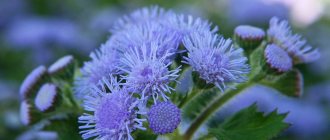The fruit tree, or shrub, medlar belongs to the Apple subfamily, Rosaceae family. The plant's homeland is considered to be China, from where it was later brought to Japan. Today, medlar is widespread in Asia, warm Mediterranean countries, and grows in Turkey, Abkhazia, the northern regions of Transcaucasia and Iran, and the Balkans. Other names for medlar: eriobothria japonica, shesek, loqua, biwa, nispero.
The trees reach 10 meters in height, but home-grown plants do not exceed 2 meters. Medlar flowers are reddish-gray or white with a pleasant smell and thick felt pubescence. It is noteworthy that the tree or shrub blooms from September to November, bears fruit in spring or late summer, and tolerates frosts down to -15 degrees very well. And the older the medlar, the more resistant to cold it is. Even if a tree is killed by frost, it grows back from the root. Trees growing in the northern parts do not bear fruit every year, but only in warm winters. The branches of the tree have thorns and the leaves are hard and pubescent underneath.
Medlar fruits have thick skin, look like small apples or apricots, and are orange in color. The fruits grow in clusters, 3-8 pieces each, with 4 large seeds inside. Depending on the variety, the fruit tastes slightly sour, sweet, sour-sweet or slightly sour, reminiscent of a combination of juicy pear and cherry or fleshy quince with a slightly sour aftertaste.
Varieties and types
The most famous plant species: Japanese and Caucasian (German) medlar. About 1,000 varieties of medlar are known in China, and 100 are known in the Iberian Peninsula and Algeria. The most famous are the following varieties:
- Komun, medium-sized fruits, slightly flattened or round, with a bright yellow matte, slightly pubescent skin;
- Premier, produces large fruits, pear-shaped, oval, yellow-orange in color with matte, pubescent skin;
- Tanaka, large oval pear-shaped fruits, yellow with an orange tint, pubescent;
- Champagne, dark yellow, pubescent, oval or pear-shaped fruits;
- Silas, the fruits are similar to apricot in taste, orange in color;
- Morozko, pods with a delicate aroma, bright yellow hue;
- Advance, Orange, Victor, bear fruit with a sweet and sour taste, orange or bright yellow in color.
Selection rules
You can eat ripe berries with pleasure; unripe ones will be sour. The fruits ripen on the branches; it is not advisable to collect them in advance.
You need to understand how the best fruits are selected based on ripeness. They should be a little soft and not have major mechanical damage. The peel should be intact, without rot.
You should not buy unripe ones, they are sour, they can be used in various dishes. You can recognize immaturity by a greenish tint and excess hardness.
The overripe ones are too soft, they are already turning sour inside, and you can smell the fermentation.
Beneficial properties and harm
The fruits contain a lot of vitamins and more than 80% water. Medlar quenches thirst well, saturates the body with useful substances and contains little sugar, so you can eat it while losing weight. People with diabetes can also eat fruits; the fruits contain a substance that promotes the production of insulin - triterpene. Fruits, leaves and seeds contain:
- amygdalin
- flavonoids
- pectin
- phenolic compounds
- organic acids
- polysaccharides
- tannins
- phytoncides
Medlar strengthens the immune system and is a good natural antioxidant. The bark is used for tanning leather, the wood is used to make kitchen utensils and souvenirs, the seeds are consumed only in processed form, ground and brewed like coffee, and decoctions and tinctures are made from them.
The leaves are highly valued by folk healers, as they contain ursolic, corosolic and pomolic acid, carafolline, plant polyphenols, and glycosides. These substances have the properties of fighting foreign bodies in the body.
It is not recommended to eat fruits if you have certain health problems:
- increased stomach acidity;
- gastritis and gastric ulcer during exacerbation;
- pancreatic diseases.
Children, in order to avoid an allergic reaction, can eat no more than 2 fruits per day, adults - 4 fruits.
Contraindications
Any product combines benefits and harm, so you need to be careful. Children may develop allergies, so if they are prone to it, it is better to avoid using it. Doctors allow children over three years old to eat exotic foods.
Contraindications include inflammation of the pancreas, gastritis with high acidity, stomach or duodenal ulcers. People with such pathologies should not drink wine, juice, or eat unripe medlar fruits.
But jam and preserves made from it have a positive effect on the sick body and are recommended during the recovery period after operations.
The nutritional value
100 g of medlar contains only 47 kcal, vitamins A, C, group B and many useful substances and microelements:
- carbohydrates - 14 g
- fiber - 1.7 g
- ash - 0.5 g
- zinc - 0.05 mg
- selenium - 0.6 mcg
- magnesium – 13 mg
- potassium - 266 mg
- calcium - 16 mg
- sodium - 1 mg
- iron - 0.28 mg
- phosphorus - 27 mg
- manganese - 0.148 mg
- copper - 0.04 mcg
Application in medicine and cosmetology
Medlar has long been used in folk medicine and has gained recognition in cosmetology. All parts of the plant are used to prepare skin care products, masks and facial lotions that help fight acne.
The flowers of the plant have expectorant properties and help get rid of accumulated mucus in the lungs and bronchi. Pregnant women are recommended to eat fruits to saturate the body with vitamins and nutrients.
Medlar, leaves and flowers of the plant are used in the following cases:
- bronchitis, asthma, cough;
- intestinal disorder;
- intoxication of the body;
- kidney filtration problem;
- high blood pressure;
- high blood cholesterol;
- liver problems.
Medlar is very useful for preventing cancerous tumors and reducing radiation. Beneficial properties help get rid of feelings of fatigue and increase the number of red blood cells. With regular consumption of fruits, the heart muscle is strengthened, the body is saturated with potassium, which is necessary for the normal functioning of the heart.
Vitamin A contained in loquat is very important for eye health and prevents free radical damage to the retina.
Decoction for cleansing the body
Boil 500 ml of water and add 1 tablespoon of dried medlar leaves. Keep the broth in a thermos for 3 hours and strain. Drink 50 ml 20 minutes before meals.
The course of taking the decoction lasts 2 weeks, after which you need to take a break for several months and repeat again. The decoction cleanses the body of salts, heavy metals and toxins, and the liver cleanses of excess bilirubin.
Alcohol tincture for severe colds
Mash 5 large fruits well, crush the seeds and combine with the pulp, pour in 100 ml of vodka and mix thoroughly. Pour into a glass container, close tightly, leave for 3 days in a cool and dark place. Strain the finished infusion and take 1 tablespoon before meals.
The tincture is very effective for colds and chronic bronchitis, and has good expectorant properties. Can be used in the treatment of asthma.
When to collect medlar fruits and how to store them
The harvest is harvested at different times. This is determined by the type of tree and area of growth:
- Japanese berry. In Turkey and the southern United States, fruits ripen in March-April, on the Black Sea coast a month later. In June-July - on the South Coast.
The fruits of the Japanese medlar reach condition only on the branch, so they are picked ripe.
Fruits are stored for three to four days in a room or refrigerator.
- The fruits of the Germanic variety are usually picked after the first frost: the fruits soften and are suitable for consumption. If frosts are not expected or the fruits are needed for medicinal purposes, the crop is harvested in November or December, the fruit is poured with saline solution and left in a cool place. After two to three weeks the pulp is tender and tasty. However, the fruits wrinkle and become smaller.
Some people prefer to harvest their medlars gradually, until early spring. Leaves for medicinal use are harvested in August. It is better to choose fruits of any variety that are medium in size and firm, without dark spots.
Medlar in cooking
The fruits are used to make preserves, jams, compotes, prepare juices, kvass, liqueur, wine, fruit salads, sauces, sherbet, and use them as a filling for baking.
Loquat and pumpkin seed jam
Ingredients:
- 1 kg of fruits
- 300 g sugar
- 4 tbsp. l. pumpkin seeds
Preparation:
- Peel the medlar and mix with sugar, place in the microwave for 10 minutes.
- Remove the mixture and add pumpkin seeds.
- Transfer to a saucepan and cook on the stove over medium heat, stirring, until the syrup has reduced by 1/3.
Loquat sorbet
Ingredients:
- 200 g sugar
- 500 ml water
- 1 kg of fruits
Preparation:
- Boil syrup from water and sugar and cool to 30 degrees.
- Squeeze the juice from the medlar, add to the cooled syrup and stir.
- Pour into glasses and leave in the refrigerator for several hours.
Storage rules
To enjoy the unforgettable taste, you need to visit the places where it grows during the harvest season (April - June). It is poorly stored and cannot be transported.
Can be kept in the refrigerator for no more than 3 days. Since they don’t store much of it, it’s not profitable to buy in reserve; everything will rot.
Growing Japanese and Caucasian medlar from seeds
The fruit from which you will extract seeds must be well ripened. Planting consists of several stages:
- take a pot with a diameter of 9 cm with good drainage holes, fill it with a mixture of peat and sand;
- water well so that the soil is completely saturated and the liquid flows out of the drainage holes;
- plant the seeds to a depth of 3 cm. You can plant all the seeds from one fruit at once or one at a time;
- cover the pot with film and place it in a warm place so that direct rays of the sun do not fall on it. Regularly remove condensation from the film by lifting it and moisten the soil with a sprayer. Sprouts do not appear from every seed; seedlings appear after a few months;
- when sprouts appear, remove the film and maintain the room temperature at 18 degrees;
- when the sprout has 3-4 leaves, transplant it into a pot with a larger diameter; for soil, mix 0.5 parts sand, 1 part turf soil and 2 parts leaf soil.
Growing Caucasian medlar from seed is carried out as follows:
- remove the seeds from the ripe fruit and soak for 3 hours in a growth stimulator solution;
- select a 2-liter pot, fill it with universal substrate for indoor plants and plant 5 seeds to a depth of 3-4 cm;
- cover the pot with film and place in a warm place, ventilate every day, lifting the film, and moisten the soil as it dries;
- after 45 days shoots should appear, after another 25 days 3 leaves will form;
- transplant each loquat sprout into separate pots using the transshipment method.
Possible problems
Indoor medlar quite easily adapts to unusual growth conditions. But if the grower makes gross mistakes in care or the microclimate in the room is completely unsuitable for the plant, then problems such as:
- Rot appeared on the roots . This is due to very abundant watering and stagnation of liquid in the substrate, especially if the room is cold.
- Curling and wilting of leaf blades . The bush is affected by a bacterial burn. The development of the disease is promoted by cold air, stagnation of moisture in the roots and an excessively large amount of nitrogen in the substrate.
- Slow growth . Associated with poor lighting or lack of nutrients.
- Pests . Scale insects, aphids and sooty fungus can settle on the plant.
Growing from cuttings
Both species reproduce well from cuttings that have good viability. This cultivation option is carried out as follows:
- take several branches of last year's growth, 20 cm long, with two developed nodes;
- cut leaves in half to reduce evaporation;
- powder the cuttings with ash;
- Plant one at a time in pots with a thick layer of drainage. Take soil from peat and sand in equal proportions, spray and water as the soil dries.
You can make a dome for the plant from a transparent material for more comfortable conditions and add “kornevin” to the water for irrigation for faster rooting. With proper care, the cuttings should take root within a month. The growth will not be noticeable for a long period of time, because the cutting will be at the stage of forming the root system. After a year, the plant can begin to grow strongly, since the root system is already fully strengthened. With proper care, a tree will gradually grow, which will delight you with beautiful flowers and juicy fruits.
Varieties
In total, there are 2 varieties of medlar, German or ordinary, (Mespilus germanica) and Japanese (Eriobotrya japonica), eriobotrya. Cultures differ in their growing season, shape and taste of the fruit.
Both crops are grown for landscape design. The Japanese variety is preferable for consumption. What does the medlar fruit look like:
- German or common medlar is similar to a wild crop. In comfortable conditions it grows up to 8 m. The tree is spreading with wide leaves. Unlike the Japanese species, trees of the Germanic variety shed their leaves. Before falling it turns burgundy;
- flowering occurs in April-May. The flowers have 5 petals, white or with a yellowish tint;
- fruits appear in September. The apple is small, 3 cm in diameter. The shade is red. The outer shell is dense. It is recommended to remove it. The pulp is slightly juicy and has a tart taste. The harvest is harvested with the first frost, the berries are allowed to freeze a little. They lose their attractive appearance, but become sweet;
- externally, the fruits of the German medlar look like large rose hips;
- The crop is grown on loamy hard soils, but it can grow on clay soil. Soil acidity may be too low. The soil is pre-treated with slaked lime.
The Japanese variety tree looks different. It does not shed its leaves in winter and remains evergreen. The crop is grown both as an ornamental and as a garden plant.
It is often grown at home. Pinch the top so that the bush does not rise too much. In a room microclimate, a tree can bear fruit:
- in the garden, medlar grows to a height of more than 8 m. The trunk is erect;
- leaf plate up to 8 cm wide, up to 25 cm long. The tree provides shade, it has a voluminous crown;
- it blooms in September. The inflorescences are a column or pyramid;
- The fruiting period occurs in winter or early spring, but the fruits do not grow every year. The tree needs 1-2 years to recover. This is not reflected in the crown;
- the optimal temperature for the normal development of an exotic plant is 15-20 0C, but it can also tolerate frosts down to -15 0C;
- the soil should not be very fertile, but the acidity of the soil should be neutral or low.
The fruit of the juicy medlar is used raw. Jam, compotes, and desserts are made from it. What does the fruit look like and how to eat an apple?
View this post on Instagram
Publication from Economy Newspaper (@hozyaistvo_gazeta) Dec 5, 2022 at 10:03 PST
The exotic fruit of the Japanese variety looks like a small pear. It is closer in color to apricot. It tastes like cherry, hawthorn, and sea buckthorn. The pulp is orange, juicy, not tart. The shell is dense and whole. In ripe fruit, brown spots may appear on it.
If the shell is dense, then it is removed, but the apple can be consumed with it. The bones are removed. They contain hydrocyanic acid, but the bones are used for cooking meat, as a seasoning. Fruits are stored for 4-5 days in the refrigerator.
Planting a seedling in a permanent place
The young tree loves light; it should be planted only in a well-lit area. Loquat cannot be planted in areas with high groundwater, as it needs good drainage.
Planting stages:
- prepare a hole with a diameter 1/3 larger than the seedling’s earthen ball;
- Place a layer of drainage on the bottom and add complex fertilizer with bone meal;
- prepare a mixture of peat, soil, humus and sand in equal proportions;
- water the planting hole and place the seedling in the hole;
- sprinkle with the prepared mixture and compact well;
- mulch the tree trunk with humus or compost.
Within a year, the tree will take root and begin to grow. It's important to do everything right.

